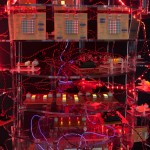Thanks to Tom for reminding me that I’d forgotten to comment on BBC Director-General, Mark Thomson’s, Royal Television Society Baird lecture “BBC 2.0: why on demand changes everything” – Probably because I was shocked to hear unicast, multicast, p2p, drag-and-drop TV and the Creative Archive all mentioned in the same talk and used as common language by the Director-General.
I have to say I’m finding it quite a weird time seeing everything actually begin to hit the scale we thought it would. We’re past the point of mid-collision, where everyone was talking – then building, into ‘reality’ where we are starting to deal with its implications.
It seems like yesterday that I was trying to convince people that online video/audio/tv/radio was going to be much smaller than the hype at the time, but much bigger in the long run (my favourite being an 1998 NAB conference where I left 3,000 people blinking, bemused at my OHP scibblings).
As with the rest of the web, it’s down to the sheer tenacity of people. I knew folks at Cisco who’d been working on video IP Multicast for 10 years (even by 1996!) and were being told “it’ll never happen” – I hope they are still there and seeing it hit the consumer domain (at Tornado we used to do Cisco’s IPTV intranet channel production).
Peggy, and everyone in the IWA crew have been evangelising (literally) since the early 90s. Before then it flips back into the realms of academia for me (streaming audio over ATM lines between Glasgow and Edinburgh in 1992).
It’d be great to know more about some of the earlier research that was going on in the 80s (Alan Boyd, the first Product Development Manager at Microsoft in 1980, pointed me in the direction of some of it) but I’d love to find out more of the original architects [puts on todo list 2007].
So, all this nostalgic rambling is to say, I can’t wait to be part of what happens next and feel pretty lucky to have been part so far.
There are a lot more post-mid-collisions in progress – CI seems to have found itself in the midst of the music sector reboot. In other areas, data is finding its way into the public domain a bit like water seeping through rock.
“There are a million simple problems that need to be solved before you should even consider trying to solve the complex ones” (37signals) is something we do a lot – lots of small steps. The trick is also to parellelise the steps into many discreet particles all of which can autonomously resolve themselves (to borrow from particle physics, let the wave functions collapse).
It’s just great to experiment live.


